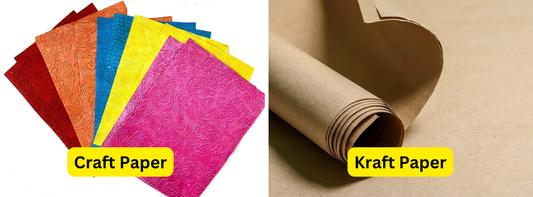Among the most popular alternatives to plastic, paper bags have emerged as a leading choice in the retail and packaging industries. They offer a simple yet effective way to reduce plastic waste and minimize environmental impact. In this article, we will explore what paper bags are, the different types available, and their environmental benefits, providing a comprehensive understanding of why more businesses are shifting to this eco-friendly option.
- Paper Shopping Bags by Material and Use: A Guide for Businesses
- What Type of Paper Bag Can Be Recycled?
- How and Where to Store Paper Bags?
-
Exploring Different Types of Paper Bags with Handles for Retail and Business
What Are Paper Bags?
Definition of Paper Bags
Paper bags are packaging products made from paper, designed for carrying and transporting various goods. They have become a staple in both retail and food industries due to their versatility and environmental benefits.
What Are Paper Bags Made Of?
Paper bags are typically made from kraft paper or recycled paper. Kraft paper is known for its strength and durability, making it an ideal material for creating bags that can carry a wide range of items. Recycled paper is also a popular option as it helps reduce the use of virgin materials, further supporting sustainable practices.
History of Paper Bags
Early Invention and Development
The history of paper bags dates back to the mid-19th century when Francis Wolle invented the first paper bag machine. Originally, these bags were simple and primarily used in bakeries. Over the years, paper bags have evolved, with new designs and applications catering to various industries.
Technological Advancements in Paper Bag Production
With advancements in technology, the production of paper bags has become more efficient and durable. Modern machines allow for mass production, improving speed and quality. Additionally, recycled paper and sustainable materials have become more prominent, further supporting the shift toward eco-friendly packaging.
Types of Paper Bags
Paper bags come in various designs and materials, each serving specific purposes depending on the industry and the type of goods they are meant to carry. Below is a detailed overview of different types of paper bags and their applications.
Flat Bags
Flat paper bags are simple, lightweight bags without gussets (side folds), making them ideal for flat or small items such as greeting cards, small accessories, or documents. They are often used in stationery stores, gift shops, and for small takeaways like sandwiches.
Key Features:
- Lightweight and cost-effective
- Suitable for packaging small or flat products
- Often made from kraft paper or recycled materials
Common Uses:
- Stationery and greeting cards
- Small food items like sandwiches or snacks
- Gift shops and retail stores
D-Cut Paper Bags
D-cut paper bags are characterized by a die-cut handle that makes them easy to carry. The cut-out "D" shape in the upper part of the bag adds to its convenience. They are frequently used in retail and fashion stores to carry clothing, cosmetics, or other lightweight items.
Key Features:
- Sturdy with a convenient built-in handle
- Available in various sizes and thicknesses
- Often used for retail shopping
Common Uses:
- Clothing and accessory stores
- Beauty and cosmetics shops
- Gift packaging
Square Bottom Paper Bags
Square bottom paper bags have a flat base that allows them to stand upright, making them perfect for heavier items. These bags are often used in grocery stores and supermarkets for packing food items like fruits, vegetables, and other groceries.
Key Features:
- Strong, stable base
- Suitable for carrying bulkier and heavier items
- Ideal for groceries and takeaway food
Common Uses:
- Grocery stores
- Food takeaway services
- Markets and delis
Paper Bags with Plastic Windows
These paper bags feature a clear plastic window, allowing customers to see the product inside. They are commonly used for baked goods, snacks, or other products where visibility is important for display purposes.
Key Features:
- Transparent window for product visibility
- Commonly used in bakeries and specialty food shops
- Can be sealed to maintain product freshness

Common Uses:
- Bakeries and patisseries
- Snack foods
- Small items that benefit from display visibility
Satchel Paper Bags
Satchel bags have gussets on the sides and a flat bottom, making them ideal for packing larger or bulkier items. They are commonly used for takeaway food items like sandwiches, snacks, or bakery goods.
Key Features:
- Flat base and side gussets provide more room
- Typically grease-resistant for food items
- Lightweight and easy to carry
Common Uses:
- Takeaway food
- Snacks and sandwiches
- Bakeries and cafes
V-Bottom Paper Bags
V-bottom paper bags have a distinct V-shape when folded flat. These bags are commonly used in bakeries for packing bread and pastries. Their design allows for easy storage and handling of baked goods without damaging them.
Key Features:
- V-shape for easy folding and storage
- Often used for baked goods
- Lightweight but sturdy enough to carry delicate items
Common Uses:
- Bakery products like bread, croissants, and pastries
- Small groceries
- Food packaging
Greaseproof Paper Bags
Greaseproof paper bags are made from materials that resist oil and moisture, making them perfect for packaging oily or greasy food items such as fries, burgers, or baked goods. These bags are a staple in fast-food restaurants.
Key Features:
- Resistant to oils and moisture
- Perfect for food with high grease content
- Maintains product freshness and prevents leakage
Common Uses:
- Fast food (e.g., fries, burgers)
- Baked goods like donuts and muffins
- Street food vendors
Pinch Bottom Bags
Pinch bottom bags have a narrow top that can be pinched closed, making them ideal for small snacks, candies, or bakery products. These bags are commonly used for dry food items and are easily sealable.
Key Features:
- Pinch-close design for secure packaging
- Commonly used for snacks and baked goods
- Can be sealed to ensure product freshness
Common Uses:
- Cookies and snacks
- Bakery items
- Confectionery stores
Mailing Bags
Mailing paper bags are designed for shipping items. They are sturdy and often come with a padded or protective lining to ensure that the items inside are safe during transit. These bags are typically used by e-commerce retailers.
Key Features:
- Durable enough to handle shipping
- Often have a padded lining for added protection
- Lightweight but strong for shipping purposes
Common Uses:
- E-commerce packaging
- Mailing clothing, books, and lightweight items
- Small-scale businesses shipping products

Shopping Bags with Handles
Shopping bags with handles are one of the most common types of paper bags used in retail stores. They are typically designed with durable handles made of twisted paper or flat paper strips. These bags are perfect for carrying medium-weight purchases and are popular in clothing stores, department stores, and gift shops.
Key Features:
- Sturdy handles for easy carrying
- Available in various sizes and colors
- Can be customized with logos and branding
Common Uses:
- Retail shopping
- Fashion boutiques
- Gift shops and department stores
Double-Layer Paper Bags
Double-layer paper bags are designed for heavy-duty use, featuring two layers of paper for extra durability. These bags are often used for carrying heavier items such as bulk foods, hardware supplies, or industrial products.
Key Features:
- Reinforced with two layers for added strength
- Suitable for carrying heavier or bulk items
- Ideal for industrial or commercial use
Common Uses:
- Bulk groceries (e.g., flour, grains)
- Hardware stores
- Industrial packaging
Common Uses of Paper Bags
In Retail and Grocery Stores
Paper bags have become a popular choice in retail, particularly in fashion stores, grocery shops, and organic food markets. Their sturdiness and environmental appeal make them ideal for customers looking for eco-friendly shopping options.
For Takeaway and Food Packaging
Restaurants and food services frequently use paper bags for takeaway orders and food packaging. Greaseproof paper bags, in particular, are useful for preventing oils from soaking through, making them perfect for carrying hot and greasy food.
For Events and Gifting
Paper bags are commonly used in special events like weddings, parties, and holidays. They offer a stylish, customizable option for gifting, providing a more personalized touch while being eco-conscious.
For Specialized Sectors (Bakery, Boutique)
Specialized sectors such as bakeries and boutiques often use paper bags with unique designs to match their brand image. Paper bags with plastic windows are especially popular in bakeries, allowing customers to see the items inside while keeping them fresh.
Advantages of Using Paper Bags
Environmentally Friendly
One of the biggest advantages of paper bags is that they are biodegradable and easily recyclable. Unlike plastic bags, which can take hundreds of years to decompose, paper bags break down naturally and have a much lower impact on the environment.
Recyclability and Compostability
Paper bags can be recycled into new paper products, reducing the need for virgin materials. They can also be composted, contributing to the health of ecosystems by breaking down into organic matter that enriches the soil.
Brand Image and Customer Appeal
In today’s market, consumers are more inclined to support brands that prioritize sustainability. By using paper bags, businesses can enhance their eco-friendly image, appealing to environmentally conscious customers who are looking to reduce their carbon footprint.
Customization Opportunities
Paper bags offer excellent customization opportunities. Businesses can easily print their logos, brand colors, or unique designs on paper bags, making them a perfect tool for brand marketing. Customized paper bags add a professional touch and increase brand visibility in a sustainable way.
Environmental Benefits of Using Paper Bags
Lower Carbon Footprint
Producing paper bags consumes less energy and releases fewer pollutants compared to the production of plastic bags. Furthermore, using recycled materials in the production of paper bags significantly reduces the overall carbon footprint.
Reduced Plastic Waste
By using paper bags, businesses and consumers can greatly reduce their reliance on single-use plastic bags, which are a major contributor to global plastic pollution. Paper bags provide a biodegradable alternative that doesn't persist in the environment for centuries.
Support for Sustainable Forest Management
Many paper bags are made from materials sourced from sustainably managed forests. Certifications such as FSC (Forest Stewardship Council) ensure that the wood used to make paper comes from responsibly harvested trees, helping to conserve natural resources and protect wildlife habitats.
Conclusion
Paper bags have become a crucial element in the fight against plastic pollution. With a variety of types and uses, they offer a versatile and environmentally friendly alternative to plastic bags. From retail and grocery stores to food service and special events, paper bags provide a sustainable solution that benefits both businesses and consumers.
By choosing paper bags, businesses can reduce their environmental impact, improve brand image, and cater to the growing demand for eco-friendly packaging. Now is the time to embrace sustainable packaging and make a positive contribution to the planet.
Looking for high-quality, eco-friendly paper bags for your business? Contact KimEcopak today and discover a wide range of sustainable paper bag solutions that align with your brand’s environmental goals!









